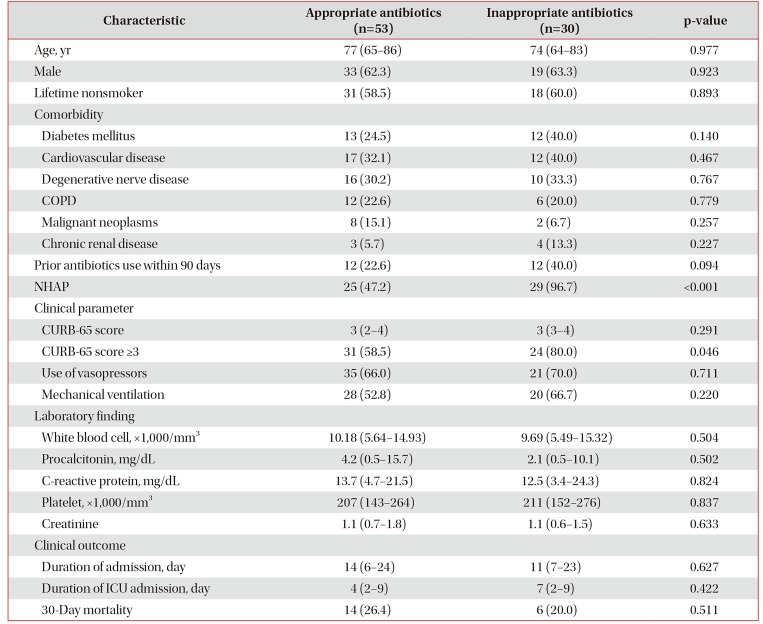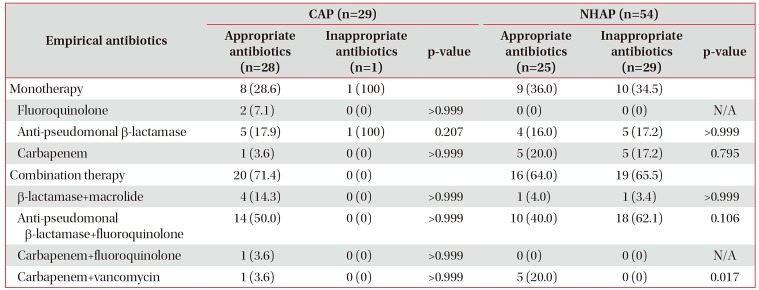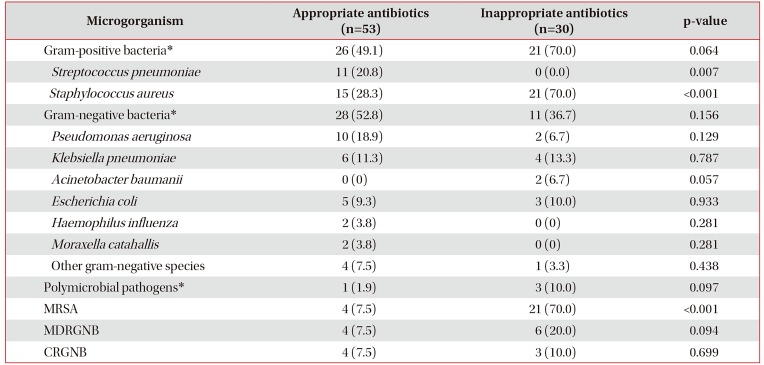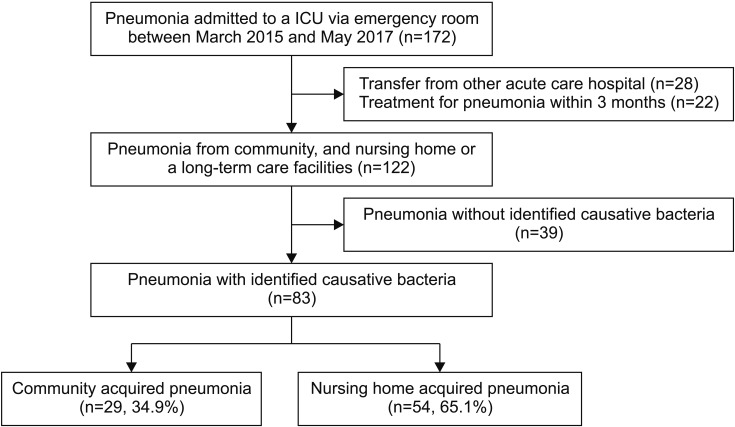1. Mylotte JM. Nursing home-acquired pneumonia. Clin Infect Dis. 2002; 35:1205–1211. PMID:
12410480.

2. Mehr DR, Binder EF, Kruse RL, Zweig SC, Madsen R, Popejoy L, et al. Predicting mortality in nursing home residents with lower respiratory tract infection: The Missouri LRI Study. JAMA. 2001; 286:2427–2436. PMID:
11712938.
3. Muder RR, Brennen C, Swenson DL, Wagener M. Pneumonia in a long-term care facility: a prospective study of outcome. Arch Intern Med. 1996; 156:2365–2370. PMID:
8911243.
4. Muder RR. Pneumonia in residents of long-term care facilities: epidemiology, etiology, management, and prevention. Am J Med. 1998; 105:319–330. PMID:
9809694.

5. Martinez-Moragon E, Garcia Ferrer L, Serra Sanchis B, Fernandez Fabrellas E, Gomez Belda A, Julve Pardo R. Community-acquired pneumonia among the elderly: differences between patients living at home and in nursing homes. Arch Bronconeumol. 2004; 40:547–552. PMID:
15574267.
6. Micek ST, Kollef KE, Reichley RM, Roubinian N, Kollef MH. Health care-associated pneumonia and community-acquired pneumonia: a single-center experience. Antimicrob Agents Chemother. 2007; 51:3568–3573. PMID:
17682100.

7. De Pascale G, Bello G, Tumbarello M, Antonelli M. Severe pneumonia in intensive care: cause, diagnosis, treatment and management: a review of the literature. Curr Opin Pulm Med. 2012; 18:213–221. PMID:
22388582.
8. Kalil AC, Metersky ML, Klompas M, Muscedere J, Sweeney DA, Palmer LB, et al. Management of adults with hospitalacquired and ventilator-associated pneumonia: 2016 Clinical Practice Guidelines by the Infectious Diseases Society of America and the American Thoracic Society. Clin Infect Dis. 2016; 63:e61–e111. PMID:
27418577.
9. Furuno JP, Comer AC, Johnson JK, Rosenberg JH, Moore SL, MacKenzie TD, et al. Using antibiograms to improve antibiotic prescribing in skilled nursing facilities. Infect Control Hosp Epidemiol. 2014; 35 Suppl 3:S56–S61. PMID:
25222899.

10. Koh SJ, Lee JH. Clinical characteristics of nursing home-acquired pneumonia in elderly patients admitted to a Korean teaching hospital. Korean J Intern Med. 2015; 30:638–647. PMID:
26354058.

11. Polverino E, Dambrava P, Cilloniz C, Balasso V, Marcos MA, Esquinas C, et al. Nursing home-acquired pneumonia: a 10 year single-centre experience. Thorax. 2010; 65:354–359. PMID:
20388763.

12. Carratala J, Mykietiuk A, Fernandez-Sabe N, Suarez C, Dorca J, Verdaguer R, et al. Health care-associated pneumonia requiring hospital admission: epidemiology, antibiotic therapy, and clinical outcomes. Arch Intern Med. 2007; 167:1393–1399. PMID:
17620533.
13. El-Solh AA, Sikka P, Ramadan F, Davies J. Etiology of severe pneumonia in the very elderly. Am J Respir Crit Care Med. 2001; 163(3 Pt 1):645–651. PMID:
11254518.

14. Lee H, Park JY, Lee T, Lee YJ, Lim HJ, Park JS, et al. Intermediate risk of multidrug-resistant organisms in patients who admitted intensive care unit with healthcare-associated pneumonia. Korean J Intern Med. 2016; 31:525–534. PMID:
26968189.

15. Carratala J, Fernandez-Sabe N, Ortega L, Castellsague X, Roson B, Dorca J, et al. Outpatient care compared with hospitalization for community-acquired pneumonia: a randomized trial in low-risk patients. Ann Intern Med. 2005; 142:165–172. PMID:
15684204.
16. Lim WS, van der Eerden MM, Laing R, Boersma WG, Karalus N, Town GI, et al. Defining community acquired pneumonia severity on presentation to hospital: an international derivation and validation study. Thorax. 2003; 58:377–382. PMID:
12728155.

17. Magiorakos AP, Srinivasan A, Carey RB, Carmeli Y, Falagas ME, Giske CG, et al. Multidrug-resistant, extensively drug-resistant and pandrug-resistant bacteria: an international expert proposal for interim standard definitions for acquired resistance. Clin Microbiol Infect. 2012; 18:268–281. PMID:
21793988.

18. American Thoracic Society. Infectious Diseases Society of America. Guidelines for the management of adults with hospital-acquired, ventilator-associated, and healthcare-associated pneumonia. Am J Respir Crit Care Med. 2005; 171:388–416. PMID:
15699079.
19. Lim WS, Macfarlane JT. A prospective comparison of nursing home acquired pneumonia with community acquired pneumonia. Eur Respir J. 2001; 18:362–368. PMID:
11529297.

20. Mills K, Graham AC, Winslow BT, Springer KL. Treatment of nursing home-acquired pneumonia. Am Fam Physician. 2009; 79:976–982. PMID:
19514695.
21. Shorr AF, Zilberberg MD, Micek ST, Kollef MH. Prediction of infection due to antibiotic-resistant bacteria by select risk factors for health care-associated pneumonia. Arch Intern Med. 2008; 168:2205–2210. PMID:
19001196.

22. Loeb M, McGeer A, McArthur M, Walter S, Simor AE. Risk factors for pneumonia and other lower respiratory tract infections in elderly residents of long-term care facilities. Arch Intern Med. 1999; 159:2058–2064. PMID:
10510992.

23. Alvarez S, Shell CG, Woolley TW, Berk SL, Smith JK. Nosocomial infections in long-term facilities. J Gerontol. 1988; 43:M9–M17. PMID:
3121716.

24. Magaziner J, Tenney JH, DeForge B, Hebel JR, Muncie HL Jr, Warren JW. Prevalence and characteristics of nursing home-acquired infections in the aged. J Am Geriatr Soc. 1991; 39:1071–1078. PMID:
1753044.

25. Harkness GA, Bentley DW, Roghmann KJ. Risk factors for nosocomial pneumonia in the elderly. Am J Med. 1990; 89:457–463. PMID:
2121031.

26. Rubinstein E, Kollef MH, Nathwani D. Pneumonia caused by methicillin-resistant
Staphylococcus aureus. Clin Infect Dis. 2008; 46 Suppl 5:S378–S385. PMID:
18462093.
27. Murphy CR, Quan V, Kim D, Peterson E, Whealon M, Tan G, et al. Nursing home characteristics associated with methicillin-resistant
Staphylococcus aureus (MRSA) Burden and Transmission. BMC Infect Dis. 2012; 12:269. PMID:
23095678.

28. Marcos MA, Jimenez de Anta MT, de la Bellacasa JP, Gonzalez J, Martinez E, Garcia E, et al. Rapid urinary antigen test for diagnosis of pneumococcal community-acquired pneumonia in adults. Eur Respir J. 2003; 21:209–214. PMID:
12608431.

29. Kim SH, Bae IK, Park D, Lee K, Kim NY, Song SA, et al. Serotype Distribution and antimicrobial resistance of
Streptococcus pneumoniae isolates causing invasive and noninvasive pneumococcal diseases in Korea from 2008 to 2014. Biomed Res Int. 2016; 2016:6950482. PMID:
27314035.








 PDF
PDF ePub
ePub Citation
Citation Print
Print




 XML Download
XML Download